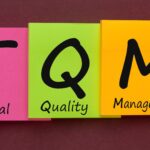In his study of total quality management in managing quality, Dale et al., (1990), outline a four-level model of the evolution of quality management. In addition to the framework it proposes, clear definitions of quality terms are also provided.
Level 1. Inspection:
Measure the characteristics of a product and compare them with its specifications; the goal here is the fitness of standards. This is the passive “Inspecting” attitude.
Level 2. Quality Control:
Inspection performed by the workers themselves with a feedback loop to the production line; here we avoid the “inspector” effect and allow some learning to take place.
Level 3. Quality Assurance:
Set of (implemented) predefined and systematic activities necessary to give confidence in the process quality; one step further. Quality procedures are designed and planned as a whole to ensure that no bad products be delivered. We do not just rely on everybody’s work and control. This introduces the notion of a coherent set of quality procedures/tests. The given confidence (in the definition of QA) is important both for the producer and for the customer.
Level 4. Total Quality Management:
Centered on quality and based on the participation of everybody which aims at the customer satisfaction and at the improvement of the company’s personnel, of the company and of the society.
The ultimate step in TQM is a quality assurance plan is operational but the management; the workers and the customers continuously interact to review/improve this plan. Quality is concerned with meeting the wants and needs of customers. One of the key and enduring definitions is that “Quality is fitness for purpose”. According to the British Standards, quality is defined as “the totality of features and characteristics of a product of service that bear on its ability to satisfy the stated or implied needs”.


